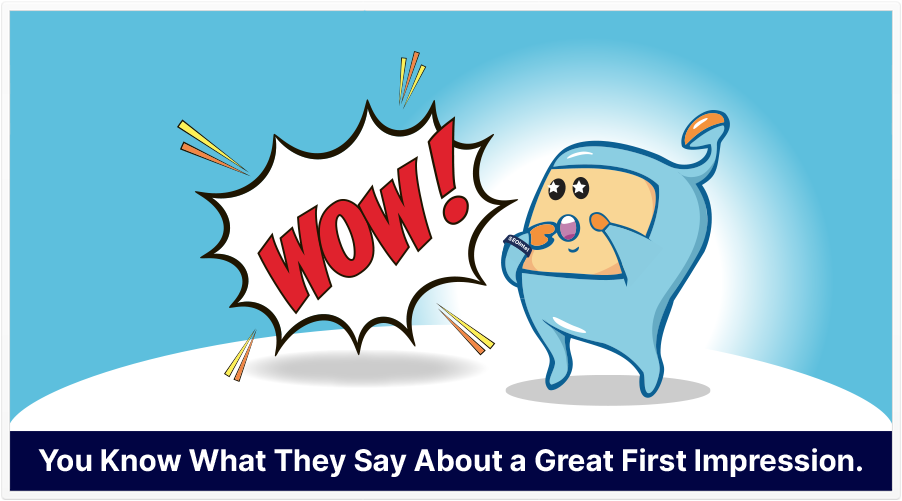While meta descriptions are not a direct ranking factor, having a meta description that accurately describes your page and gets the interest of a user can help you get that click to your page and can indirectly affect rank.
If you are in the top 3 in Google and have a better meta description than your competitors, you will definitely get that click. That is what makes great meta descriptions important.
In this article, you'll learn how to write meta descriptions that get clicks.
You'll discover the 7 traits that all meta descriptions should have, some examples to help you along, and the 7 step process for writing great meta descriptions.
Let’s start at the beginning. What is a meta description?
The word meta is actually a prefix, and in this context, it means unseen.
Unseen?
Yes. Technically, the meta description of a web page is actually part of something called metadata. Generally speaking, metadata (at least for web pages) aren’t usually seen by the casual end-user.
“But,” you ask, “if they’re not seen, why even put effort into them?”
Because your meta description is read by the search engines and can be used to help search engines get a better understanding of what your web page is about.
In fact, even though meta descriptions aren’t usually seen by the typical end-user, they can be (and most often are) displayed on the search engine results page.
When you look at a Google search results page, you’re seeing a number of listings. With each listing, some of the text you see is from the meta description of the associated web page, pulled from the page’s code.
Note: This is not always the case, but it is a good portion of the time.
Even if meta descriptions aren’t a direct ranking factors, if they’re clicked on more often in search queries and their associated pages have fewer bouncebacks, then good meta descriptions can have a positive correlation to higher rankings.
A good meta description is accurate, speaks to your target audience where they are along the buyer’s journey, and gets clicks (and fewer bounces than the other listings on the search results page).
This is why writing accurate, helpful, and brief meta descriptions (of roughly 120 characters, max) is so important.

Here are the 7 traits:
This topic is about a larger subject: search engine optimization or SEO. Part of that involves creating web pages that are full of great content. This content should be so good that it competes with the top-ranking pages for its target keyword.
That’s what everything boils down to: a person does a Google search, sees the results, and picks one of the best ones. Hopefully, it’s yours.
But, even if they don’t pick yours first, they probably keep a mental note of which ones seemed appealing to them. (If you apply what you’ll learn here, yours should most definitely be one of them.)
That means that yours will definitely be one of the most well-considered ones.
A great SEO meta description is prime real estate!

When writing your meta description, it’s good to think of your page’s primary keyword, as well as any long-tail keywords, and try to weave them in. Don’t forget that your searcher has an intent and that intent may be deeper than the simple query that they entered.
That’s why it’s important to go a little beyond basic keyword research and actually do research on the state-of-mind of the person we think wants to come to our page.

This one requires little explanation. Something that’s well-written is easier to understand and follow.
Try not to use big words or cause the reader to stumble. Remember, most readers don't want to have to think to figure something out. They love a good article that is clear and concise so they don't have to try to figure it out on their own.
This is probably one of the more important aspects of an amazing, quality description.
This is foundational: every good meta description conjures some form of curiosity or self-interest–otherwise, the searcher won’t click on it.
Good descriptions are written with an understanding of the search intent of the visitor, and they’re worded in a way that piques self-interest and curiosity.
Curiosity and self-interest go well beyond this topic–they’re each a major factor pertaining to why we do a lot of the things we do.
Don't be so abstract that your potential visitor doesn’t know what to think. Confused users don’t click.
The best meta description piques curiosity, yet balances that curiosity with specificity.

This is similar to the trait of curiosity and self-interest, but deserves its own sub-head. A great SEO meta description starts something (begins a thought or idea) and gets the searcher to want to continue…onto your page.

That’s the goal, right? Someone enters a search query into a search engine, they may see some search results snippets, and decide to visit your blog post (or web page), which would result in organic traffic to your page.
Tip: be mindful of active voice (as opposed to passive voice). Basically, active voice is where the subject does the action. Passive voice is where something is done to the subject.

Before the strategy is laid out, here are a few good examples of meta descriptions to follow.
Keep in mind that the meta description is meant to work hand-in-hand with the title, so if a meta description doesn’t have the targeted keyword in it, the meta title very likely does.
(And the meta description may have a variation of the target keyword, which can offer some diversity and target more keywords.)
Each template has a 4-part structure:
Meta description: Do you use a multi-step sales process? Do prospects have to think about investing with you? How often do they return?
Asking questions can be a great way to get people to think about something that’s on their minds, or even remember something they’ve been questioning.
Meta description: Understanding this one ‘meta metric’ can help you gain a better understanding of how people use your site.
While the source of this news doesn’t use the term meta metric, it did talk about a search metric that could encompass other metrics, which, in a way, gives it a bit of a higher standing than some of the other metrics.
Meta description: Do you use Google Ads? You may want to know about this.
The phrase, You may want to know about this, seems to imply that there’s something important that the reader either does or doesn’t know about, but which they, at least, have to ensure they’re aware of.
Here’s another example of a meta description that conveys FOMO: If you use Google Analytics, this may be the most important 30-second feature you’re missing out on.
This one says that it’s a feature the reader is actually missing out on. And…it only takes 30 seconds.
Who wouldn’t want to know about that?
Meta description: Yes, with URLs, upper and lower case can make a difference. Google’s John Mueller discusses a few examples of this.
The title would contain a yes-no question, and it is answered in the meta description.
Meta description: If you’ve wondered how many keywords your content should cover, [then] this may be of interest.
Meta description: Does the weather forecast an impending natural disaster? Here’s how to start protecting your business.
This one’s easy to explain. Problem: impending natural disaster. Solution: here’s how to start protecting your business.
Meta description: From an SEO perspective, is there any value to removing old news or old content?
Just so that you know the assumption that’s questioned here, in SEO, there’s a concept known as Quality Score, which is an overall measurement of the quality of all of the pages of a site.
The more quality pages you have, the better your quality score.
With that comes the idea that if you remove old news, your Quality Score will increase.
But is this an accurate assumption?
That’s the assumption that’s questioned in the meta description, and for the ideal reader (who is serious about their site’s Quality Score), they’ll want to know the answer to this, and will click to find out more.
Meta description: Want to gather data while respecting privacy? Here are 5 things to keep in mind.
Sometimes, people like specifics, such as numbers and precise statements. In fact, list-based content are some of the most popular types of content formats.
That’s why the ‘5 things’ statement would be appropriate.
Meta description: Lily and Mando of Lily and BAE shared a short clip where they talk about their 2-year YouTube success.
It’s not always easy to summarize things into a 2-sentence, sub-120-character statement, but if you can do it, it’s another option for you.
Meta description: Can your affiliates be hurting your site’s SEO? Overall, Google’s John Mueller wouldn’t worry too much.
A lot of affiliate managers (or vendors) would probably never consider that their affiliates can be hurting their SEO. If the searcher is an affiliate manager who cares about their SEO, then this is something they should be concerned about.
Meta description: On October 20, 2021, from 12 PM to 1 PM EDT, Google will host a webinar to help you get online with Google Ads.
This one’s pretty straightforward.
For a past event, or to begin a story, you can say something like: Learning how to write a good meta descriptions was hard, until I read this…
Meta description: Google: “If it’s slow, it’s slow; if it’s fast, it’s fast. It’s not an attribute of the kind of hosting that you have.”
Using a quote from a recognized authority (and mentioning that authority) can really help to lend credibility to your content. Bonus points if the quote you use has your targeted keyword (or some variation) in it.
Meta description: Chances are, some of your pages are better than others. Do you know which ones? Find out in less than 4 minutes.
For people who have a number of landing pages, it’s reasonable to think that some of their pages are more engaging than others. They probably know that.
But…do they know which ones?
Asking them that question is intriguing. It will cause someone to wonder which ones are better? I should probably find out so that I can focus more of my ad dollars on those ones.
And then, the promise comes when you tell them that finding out only takes 4 minutes. (Actually, it’s not just a promise: it’s a promise that’s also convenient, because of the small time requirement.)
That can make for a very compelling description.
Meta description: If you’ve seen such unexplainable changes in Search Console, the AMP Report, or Core Web Vitals, this may be the reason.
This is actually a more specific variation of the if-then statement. It works well for content that offers suggestions as to why someone might be having a particular problem.
So, that ends (or maybe begins) the 14 examples I have for you. Equipped with those, let’s dive deeper.

Alright, here’s what you’ve been waiting for!
Because I want this to be a seamless process, I decided that we should begin where a previous process ends: research. Notice that I didn’t say keyword research. Yes, keyword research plays a role, and you should definitely do it, but as far as overall research is concerned, keyword research is only a part of a larger preliminary research process.
It’s beyond the scope of this article to tell you what kind of preliminary research you should do, but some examples are:
Searcher intent is important, and worthy of consideration.
Acknowledgement of The Buyer’s Journey (where your prospect is on the purchase decision) and intent are critical steps in your research.
When you have a firm grasp on those two, you’ll be prepared for the next step.
This is a 2-part step, but the 2 parts go hand in hand.
Which stage of the Buyer’s Journey is your ideal visitor?
Are they at an early stage of the journey, where they’re aware of a problem, desire, or need?
Or, are they further along the journey, at a later stage where they may be considering doing business with you, and are doing their final bit of research?
Where they are will determine what you write.
Likewise, what’s the intent behind their search query?
Is their intent informational, navigational, commercial, or transactional?
This is where you’ll have to make some strategic decisions. Will you use one page to target one ‘intent,’ or use one page to target multiple ‘intents’?
Google’s John Mueller said that either way can work, but that if you try to target multiple ‘intents’ within the same page, Google will pick one ‘intent’ over the other.
We know that great meta descriptions entice some sort of curiosity and self-interest.
At this point, you know about your prospect/visitor and what they’re looking for (the search intent).
So, what do you have to say to get their attention?
And here’s what’s probably an even better question: How can you stand out among other sites?
If you’ve looked at the search engine results pages of your target keyword, you’ve probably seen that the meta descriptions you’ll be competing with are quite well-written.
So, how do you stand out among those?
Well, you state something that’s hopefully different than what most of the other meta descriptions are saying.
For example, the meta description of this page is:
With The 7 Traits of (Almost) All Great Meta Descriptions, learn how to write meta descriptions that get clicks.
If you came to this page via a search result, is that the meta description you saw?
If you clicked on it, then it compelled you to do so.
Why?
Probably because your curiosity caused you to click.
Likewise, you can do something similar.
Say something that stands out and piques interest.
Use the 14 templates provided above (and heck, go beyond those). Something will come to you as a great example you can modify for your own use.
If you decide to be bold in order to get attention, be sure to live up to it.
Write something that piques reader's curiosity and interest.
Use everything you know: your research, your targeted search intent, and other things you’ve identified.
As long as you can still pique curiosity, say something meaningful, and use some variation of your target keyword.
For years, 120 characters has been said to be the limit for meta descriptions.
With today’s smaller devices, know that fewer characters, such as 100 or even 90 will be all your reader sees. However, Google will take note of everything you have past the 120 characters. Ths is an SEO technique that works well.
Remember, if your meta description exceeds the space allotment on a search results page, it may not fully display.
If the Googlebot doesn’t think that a meta description is an accurate portrayal of what’s on the page it may not show your chosen meta description.
To avoid this, make sure that what is in the meta description can be found on the page too.
That’s It…For Now
Writing a good meta description comes down to:
If you create quality content, combined with solid on-page SEO, a good title tag and a great meta description, you’ve probably got a winner on your hands.
Can a good quality description help with click-through rates?
Definitely, especially if your description is one of the better ones on the search results page.
If I take content from the page, and use that as the meta description, would that be viewed as duplicate content?
No, it wouldn’t, because the meta description is, ideally, like a snippet of what’s in the actual content of the page. This is something I actually recommend you do. Something to take note of though is to write unique meta descriptions for each page of your site and to avoid having duplicate meta descriptions.
Does each page have to have its own unique meta description?
Ideally, yes.
In fact, when it comes to SEO and search engine rankings index numerous individual pages from single websites.
Each page has a chance to rank. Each unique page should, ideally, have its own individual meta description.
What about search keywords?
Optimizing a page for one keyword phrase is important. Put that keyword phrase (or a variation of it) in your meta description tag. Definitely try to have it in your title.
It’s good to have that meta description be the same as the opening of your body content or article introduction.
Also, when typing your meta description, keep in mind that if your page is shared on social sharing sites, it’s usually the meta description that will be displayed on the social media platforms. That means that your meta description might not just be seen on search engine results, but also on social sharing sites.